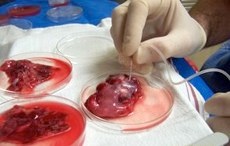Fertility preservation technology has expanded rapidly in the last 5-10 years. Current options include both well-established treatments (such as embryo freezing) and experimental approaches (such as ovarian tissue freezing). Choosing which to pursue, if any, is a highly personal decision and is best made after learning about all of the options in consultation with an oncologist and reproductive endocrinologist.
some current approaches to preserving fertility
-
1) In Vitro Fertilization with Embryo Freezing
-
In vitro fertilization (IVF) with embryo freezing is the most successful method of fertility preservation currently available. This technique is virtually identical to standard IVF however it is contrasted by the fact that therapy is concluded with the process of embryo freezing (instead of embryo transfer). Embryos can stay frozen for years, and when the patient is ready to conceive, they are thawed and transferred back to the patient. Just as with standard IVF, the process takes 4-8 weeks, which can be a major limitation for cancer patients in need of urgent chemotherapy.
-
-
2) In Vitro Maturation with Embryo Freezing
-
In vitro maturation (IVM) with embryo freezing is very similar to that which is accomplished with IVF (see above). The main advantage of IVM is that it requires much less treatment time than IVF. For extremely urgent situations, IVM can potentially be completed in a matter of days. Another theoretical advantage of IVM is its association with lower estrogen levels compared to IVF. This is an especially important distinction for patients with estrogen-sensitive cancers such as those arising from the breast or uterus.
-
-
3) Egg Freezing
-
Egg freezing (oocyte cryopreservation) involves harvesting eggs from the ovary and then freezing them for use in the future. The treatment takes place over several weeks and begins with stimulation of the ovaries to produce many eggs in each ovary. Recent advances in laboratory techniques involving the freezing method have led to improvements in pregnancy rates and made egg freezing a very popular fertility preservation technique. The main advantage of egg freezing over IVF is that a male partner is not required.
-
-
4) Ovarian Tissue Cryopreservation
-
Ovarian tissue cryopreservation is a highly experimental approach to fertility preservation where a whole ovary is sectioned into small pieces that are then frozen. Each piece of tissue contains many eggs, each with the potential to be used in achieving pregnancy in the future.
-
-
5) Whole Ovary Freezing
-
Therapies utilizing whole ovaries are extremely experimental.
-
This approach involves surgical removal and freezing of an intact ovary. When reproduction is desired, the ovary is thawed and transplanted back to the patient.
-
-
6) Combination Therapy
-
In some situations, more than one fertility preservation intervention can be performed. Examples of this include combining in vitro maturation (IVM) with ovarian tissue cryopreservation or combining IVM with IVF.
-
-
7) Sperm Freezing
-
For male patients, fertility preservation is accomplished by freezing sperm. This is a very simple and efficient intervention where ejaculates are processed and sperm is stored for future use.
internet resources
-
www.myoncofertility.org
-
www.livestrong.org
For more information about fertility preservation, please contact us at 707.259.1955 or info@napavalleyfertility.com.


